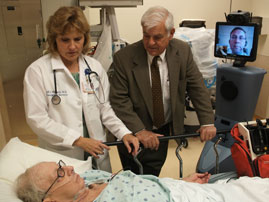
Case Study, Branding, Logistics, Media Training, Special Events, Public Relations
St. Joseph Mercy Oakland Hospital: Michigan Stroke Network Launch/Press Conference
Across Michigan, hospitals are scrambling to secure physicians in a number of practice areas. According to an occupational forecast report released by the Michigan Department of Labor and Economic Growth, by 2012 there will be a shortage of 430 physicians statewide.
There are an estimated 200,000 people in Michigan living with the effects of a stroke. According to the American Heart Association, stroke is the third leading cause of death in the United States and the foremost cause of long-term disability cases.
While many of Michigan’s hospitals have neuroendovascular (stroke) specialists on staff, others cannot support a dedicated stroke expert available around the clock. To offset limited access to quality physicians and resources, hospitals – particularly those in remote areas – are turning to new strategies and innovations such as telemedicine.
INSIGHT
St. Joseph Mercy Oakland hospital (SJMO) is a leading health care provider in southeastern Michigan and the first certified primary stroke center in the state. The hospital possesses some of the nation’s leading experts in stroke treatment and prevention.
A member of the Trinity Health system, SJMO has the resources to share its medical knowledge with other hospitals throughout the state. Furthermore, SJMO is dedicated to improving the quality of health for the overall community by providing access to technology and clinical care.
STRATEGY
To address the need for access to quality stroke care statewide, SJMO launched the Michigan Stroke Network, a collaborative network of hospitals with access to the 24/7 availability of neuroendovascular specialists, who observe, monitor, diagnose and treat patients at their local hospitals.
By launching the Michigan Stroke Network, SJMO sought to redefine geographic boundaries and eliminate barriers to quality health care. Through the use of Remote Presence™ Robotics, the Michigan Stroke Network ensures that hospitals, regardless of their size, location or resources, can offer every patient the most advanced stroke care available. As a key component of the service, SJMO initially deployed nearly two dozen RP-7 robots to hospitals throughout the state.
The Michigan Stroke Network is funded by SJMO with no associated fees for participant hospitals to receive the Remote Presence Robots and relatively minimal costs to the participating hospitals to facilitate the installation of the telecommunication and monitoring equipment.
CAMPAIGN
To promote the launch/availability of the new program, SJMO sought the counsel of its PR agency of record and communication partner – Marx Layne & Company. Recognizing the importance of this ground-breaking initiative as well as the value a well executed media relations campaign would have in creating awareness about the Michigan Stroke Network, Marx Layne & Company devised a strategic and comprehensive action plan.
For this campaign, our strategy was to position SJMO as a health care leader at the forefront of technological advancements in medicine as well as a compassionate and caring “good neighbor” within the health care community. From the onset, we engaged in a series of strategy meetings and preparation briefings with the hospital.
In addition to our media outreach responsibilities, the hospital also depended upon our team to manage all relevant aspects of the campaign to ensure its success. We devised a strategy that included conducting media training (in addition to key messages, Q&As and remarks) for hospital executives/doctors participating in the event; creating compelling CD press kits and all related materials (press releases, Bios, FAQs and fact sheets); assisting the client in launch logistics; as well as pre, day-of and post media outreach.
To maximize exposure for the Michigan Stroke Network, we gave advance coverage of the program’s launch to a high profile media outlet. Leveraging our preexisting relationship with the Associated Press (AP), we coordinated a feature story opportunity that included interviews with SJMO’s CEO, one of the Michigan Stroke Network physicians and the robot manufacturer. Given the potential local, regional and national reach of the AP, this strategy became a linchpin of our effort to garner as much media coverage as possible. Per our directive, the story was embargoed until the launch day.
To properly execute the launch of the Michigan Stroke Network, Marx Layne & Company coordinated a press conference and a live simulation at the hospital, complete with the SJMO Stroke Team physicians diagnosing a mock patient via a Remote Presence Robot.
Leading up to the event date, our team reached out to all relevant media outlets including daily print publications, community newspapers, business publications, health care trade publications, news radio and TV.
RESULTS
The AP feature story was published on the morning of the press conference and as we anticipated, it was picked up regionally and nationally. Interest in the AP story afforded us the opportunity to generate high profile publicity in such publications as USA Today, Detroit News, Newsday (NY) and the Washington Post.
Simultaneously, as the AP story blanketed the country, locally our press conference was underway and garnering attention from local TV and radio media outlets. The press conference event generated coverage by popular local outlets including FOX 2 (which aired two separate stories), Action News 7 and WJR-AM news radio.
Following the Michigan Stroke Network launch, we were able to secure additional news interest. Post-media coverage included local news staples such as the Detroit Free Press and Michigan FrontPage and national outlet, MSNBC.com. Overall, the media coverage we generated totaled more than $ 1.1 million in PR value.
Since the launch of the Michigan Stroke Network, additional robots have been deployed across the state and lives have been saved. Success stories continue to be generated about hospitals that have utilized the network and interacted with a remote presence robot to save a live.
